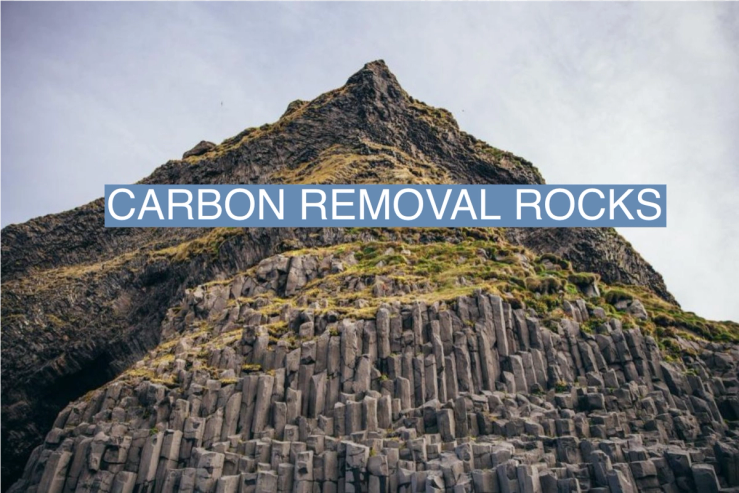The News
A new carbon capture technique that accelerates a millenia-old process is drawing major investor interest — most recently with a $57-million bet in December. By some estimates, enhanced rock weathering (ERW) could remove up to 2 billion metric tons of carbon dioxide per year, equivalent to a fifth of the amount that climate scientists say the world needs to remove annually by 2050.
Actually calculating the amount of carbon removed is tricky, however, and the technology risks running into the same kind of problems that have led to widespread greenwashing in the embattled carbon credits market. That may ultimately hold it back from gaining widespread legitimacy.
Know More
The process of ERW involves spreading crushed up rocks like basalt onto farmer’s fields. When rainwater hits these volcanic rocks, it triggers a chemical reaction that converts the carbonic acid in the rain into dissolved bicarbonate, releasing beneficial nutrients into the soil. The bicarbonate is eventually carried by rivers and streams to the ocean, where it can become the shells of sea creatures like phytoplankton and oysters. When the organisms die, the carbon remains permanently sequestered on the ocean floor. This process normally takes hundreds of thousands of years, but ERW companies say they can speed it up to a few years’ time.
Some firms are sufficiently convinced to start banking on the technology. In December, Frontier, the carbon-removal initiative led by the payments firm Stripe, made a $57.1 million carbon removal purchase, its largest to date, from San Francisco-based ERW startup Lithos Carbon. Microsoft also inked a deal with London-based UNDO last year to remove about 5,000 metric tons of CO2 over the next 20 years to help the tech giant become carbon negative by 2030. Even the U.S. Department of Energy is investing, with plans to make $35 million worth of CO2 removal purchases from companies pursuing technologies such as ERW.
Simon Manley, Head of Carbon at UNDO, estimates that his company’s tech costs $270-$400 per metric ton removed. And Lithos’ deal with Frontier puts their current price at $408. This is much more cost-effective than direct air capture (DAC), which can run upwards of $600 per metric ton, but relatively expensive when compared to reforestation, which comes in at about $50 or less, or even sequestering carbon by producing biochar, which is about $180. (ERW firms — as well as DAC ones — expect their costs to fall over time.)
Katie’s view
When compared with more expensive and technologically immature approaches to carbon removal like DAC, ERW looks like a safer bet for investors, and should be able to scale with relative ease. The fundamental science behind it is well established and understood, the materials used in the process are readily available, and farmers have seen clear benefits from spreading silicate rocks like basalt on their fields.
But to play a more meaningful role in decarbonization and avoid a similar fate as forest carbon credits, ERW companies will need to converge around rigorous, industry-wide standards for measurement, reporting, and verification of CO2 removal.
This is not an easy task. When taking field samples, it’s difficult to parse out the degree to which fluctuations in various measurements are due to carbon sequestration from rock weathering versus other chemical or biological processes, and hard to account for the potential leakage of carbon as it travels through rivers and streams to the sea.
Lithos’ technique for verifying CO2 removal is one of the primary reasons that Frontier invested in the startup. Hannah Bebbington, Deployment Strategy Lead at Frontier, said Frontier was impressed that Lithos primarily relies on frequent soil measurements rather than modeling, and appreciated its open data ethos. Lithos plans to publish all of its findings for the broader scientific community to learn from.
UNDO’s approach, which relies on a combination of soil and water sampling as well as modeling, is currently undergoing a certification process with Puro.earth, a platform that connects buyers of carbon credits with certified CO2 removal projects. Two years ago, Puro published the world’s first ERW carbon crediting methodology, outlining the standards ERW projects must adhere to in order to be eligible for Puro’s carbon credits. (Lithos’ co-founder and CEO Mary Yap told me she found Puro’s approach insufficiently rigorous.)
So far, no ERW project is fully certified with Puro or any other carbon standard organization such as The Gold Standard or Verra, which has itself been criticized after its rainforest carbon offsets were found to be largely worthless. UNDO expects to be verified through Puro by the summer. But perhaps because that’s yet to happen, carbon credit rating agencies such as BeZero haven’t evaluated the legitimacy of ERW credits.
None of this means ERW-related carbon credits aren’t available for purchase. Corporate customers can buy such credits through either Lithos or UNDO right now, and individuals can purchase credits through UNDO as well. According to CDR.fyi, a website that tracks carbon dioxide removals, purchases, and deliveries, there are 21 ERW companies around the world, 13 of which already have buyers.
All of this could be a bit premature.
Sara Vicca, a professor of bioscience engineering at the University of Antwerp in Belgium, said thus far, there’s been too little research into fluctuations in the level of organic carbon in the soil from decomposing organic matter, and how that interacts with and affects the level of inorganic carbon introduced to the soil through rock weathering. “You can’t simply measure the CO2 flux on the soil and conclude anything about what’s going on with the weathering,” said Vicca.
And while Puro now has a crediting methodology for ERW, that doesn’t stop other agencies from developing alternate standards, potentially leading to confusion in the industry and a race to the bottom as buyers seek the cheapest credits available. In an attempt to avoid this, nonprofit climate organization Cascade is working with experts in the space to develop industry-wide technical standards that UNDO’s Manley said will become available in June.
“We are literally at the foothills of the journey right now,” Manley said.
Room for Disagreement
To some extent, it’s possible that no amount of rigor, structure, and data will ever be enough when trying to measure and model a process that takes place over many years and across such broad and varied geographies. Combined with the urgency of addressing climate change, buyers and investors may have to get used to accounting methods that leave some room for error when it comes to ERW specifically, and carbon removals generally.
Vicca believes that we don’t yet know enough to get a truly accurate estimate of the amount of CO2 removed through enhanced weathering. “But maybe the question then is how strictly accurate do you need to be for the CO2 crediting?” she asks.
It’s possible that we’re getting as close as we need to in order to trust ERW, said Professor David Beerling, Director at the Leverhulme Centre for Climate Change Mitigation at the University of Sheffield, which conducts research on ERW technologies. “I would say we’re maybe one or two years away from having a self-sustaining industry that can sell carbon credits with confidence, and bring in some of the really big buyers that would make a difference.”
The View From Brazil
While most of the world’s ERW companies are located in North America and Europe, experts say that rocks weather more quickly in tropical climates. The Germany and Brazil-based company InPlanet is the only ERW company operating in South America. It’s signed a pre-purchase agreement with Frontier on behalf of Stripe and Shopify, and has a goal of removing 1 million metric tons of CO2 by 2026 through its work with farmers in Brazil.


